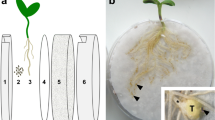Summary
Haustoria ofCuscuta odorata R. & P. andC. grandiflora H.B.K. show continuous traces of sieve elements, connecting the phloem of the host with that of theCuscuta shoot. The continuity of this haustorial phloem is discernible by callose fluorescence after staining with aniline blue. The fine structural criteria for sieve tubes are analyzed electronmicroscopically, with special respect to sieve pores, P-protein, and a distinct wall-standing smooth surfaced ER. Within the central part of the haustorium sieve tubes are elongated, while the elements abutting the phloem of theCuscuta shoot are nearly isodiametric in shape. Both elements are associated with rather large companion cells, derived from an unequal division.
Similar content being viewed by others

Literatur
Bennett, C. W., 1944: Studies of dodder transmission of plant viruses. Phytopathology34, 905–932.
Currier, H. B., 1957: Callose substances in plant cells. Amer. J. Bot.44, 478–488.
Dörr, I., 1968: Zur Lokalisierung von Zellkontakten zwischenCuscuta odorata und verschiedenen höheren Wirtspflanzen. Protoplasma65, 435–448.
—, 1969: Feinstruktur intrazellular wachsenderCuscuta-Hyphen. Protoplasma67, 123–137.
—, 1972: Der Anschluß der Cuscuta-Hyphen an die Siebröhren ihrer Wirtspflanzen. Protoplasma75, 167–184.
—,Kollmann, R., 1975: Strukturelle Grundlagen des Parasitismus beiOrobanche. II. Die Differenzierung der Assimilat-Leitungsbahn im Haustorialgewebe. Protoplasma83, 185–199.
— —, 1976: Strukturelle Grundlagen des Parasitismus beiOrobanche. III. Die Differenzierung des Xylemanschlusses bei O.crenata. Protoplasma89, 235–249.
—,Visser, J. H., Kollmann, R., 1979: On the parasitism ofAlectra vogelii Benth. (Scrophulariaceae). III. The occurrence of phloem between host and parasite. Z. Pflanzenphysiol.94, 427–439.
Israel, S., 1976: Licht- und elektronenoptische Untersuchungen der Assimilatleitbahnen in den Haustorien vonCuscuta odorata. Diplomarbeit, Botanisches Institut der Universität Kiel.
Koch, L., 1874: Untersuchungen über die Entwicklung der Cuscuteen. Bot. Abhandl.2 (3), 1–137.
Kuijt, J., 1969: The biology of parasitic flowering plants. Berkeley-Los Angeles: Univ. of California Press.
—,Toth, R., 1976: Ultrastructure of angiosperm haustoria—a review. Ann. Bot.40, 1121–1130.
Leduc, E. H., Bernhard, W., 1967: Recent modifications of the glycol methacrylate embedding procedure. J. Ultrastruct. Res.19, 196–199.
MacLeod, D. G., 1961: Some anatomical and physiological observations on two species ofCuscuta. Trans. Bot. Soc. Edinb.39, 302–315.
Peirce, G. J., 1893: On the structure of the haustoria of some phanerogamic parasites. Ann. Bot.7, 291–327.
Rosenberg, M., Bartl, P., Leško, J., 1960: Water-soluble methacrylate as an embedding medium for the preparation of ultrathin sections. J. Ultrastruct. Res.4, 298–303.
Sallé, G. C., 1979: The endophytic system ofViscum album: Its anatomy, ultrastructure and relations with the host tissue. In: Proceedings of the Second Symposium on Parasitic Weeds (Musselman, L. J., Worsham, A. D., Eplee, R. E., eds.). Raleigh, N. C.: North Carolina State University.
Schumacher, W., 1934: Die Absorptionsorgane vonCuscuta odorata und der Stoffübertritt aus den Siebröhren der Wirtspflanze. Jb. wiss. Bot.80, 74–91.
Smith, M. M., McCully, M. E., 1978: A critical evaluation of the specificity of aniline blue. Protoplasma95, 229–254.
Thoday, M. G., 1911: On the histological relation betweenCuscuta and its host. Ann. Bot.25, 655–682.
Thomson, J., 1925: Studies in irregular nutrition. No. 1. The parasitism ofCuscuta reflexa (Roxb.). Trans. Roy. Soc. Edinb.54, 343–356.
Truscott, F. H., 1958: On the regeneration of new shoots from isolated dodder haustoria. Amer. J. Bot.45, 169–177.
Author information
Authors and Affiliations
Rights and permissions
About this article
Cite this article
Israel, S., Dörr, I. & Kollmann, R. Das Phloem der Haustorien vonCuscuta . Protoplasma 103, 309–321 (1980). https://doi.org/10.1007/BF01276276
Received:
Accepted:
Issue Date:
DOI: https://doi.org/10.1007/BF01276276



